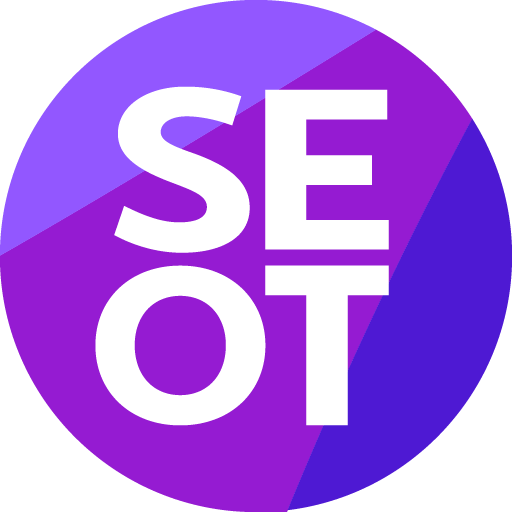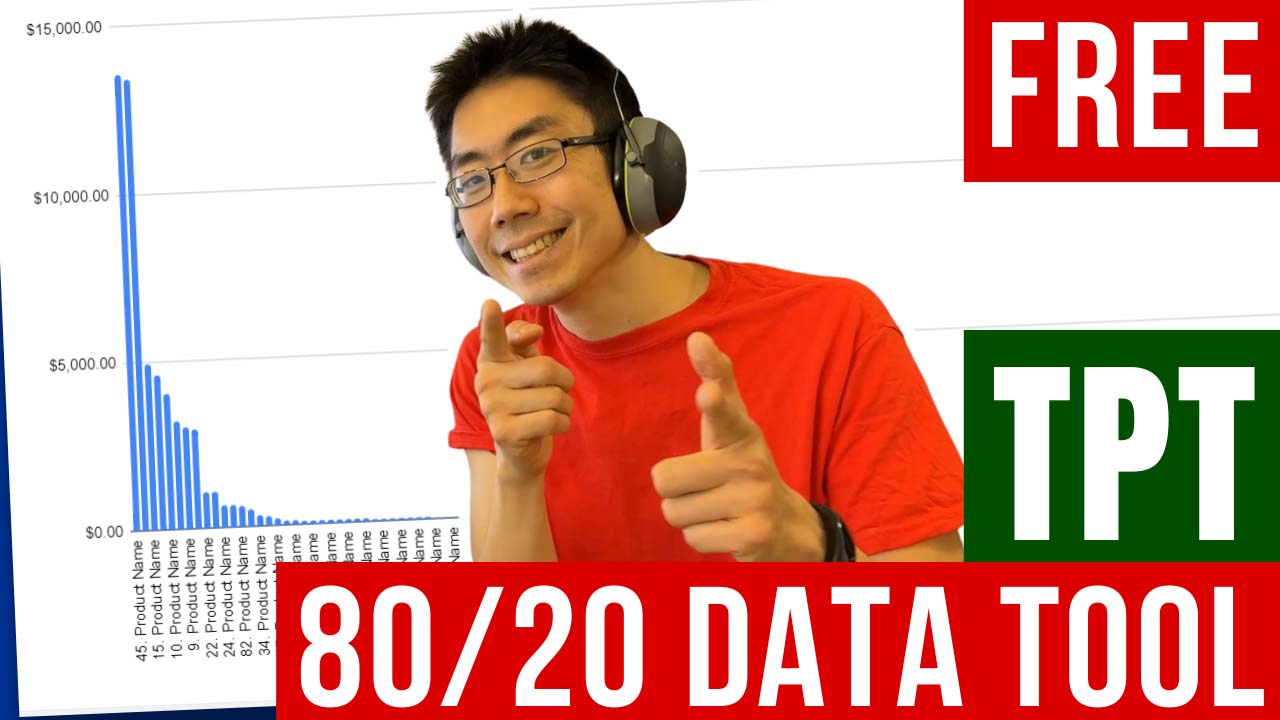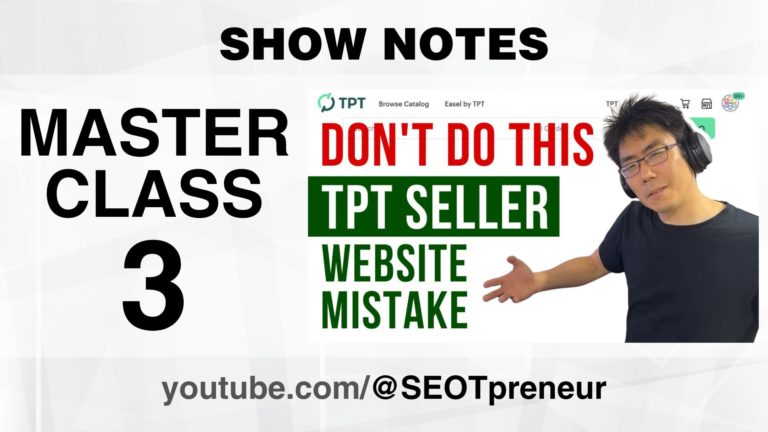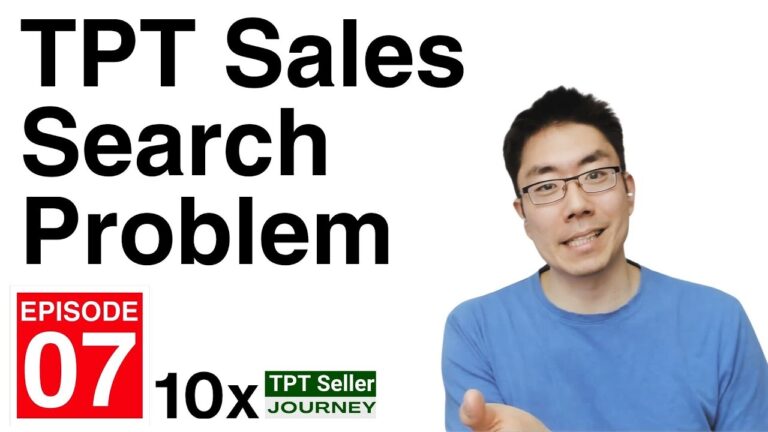FREE TPT Data Analysis Tool: 80/20 Visualization Chart to Sharpen Your TPT Business Strategy – Episode 019
Episode 019 is about a FREE TPT Data Analysis Tool to help you use the 80/20 Rule to develop your TPT business strategy.
Watch the Episode
Click here to watch on YouTube.
Download the FREE 80/20 TPT Data Analysis Tool:
Click here to get a copy of the Google Sheet
NOTE:
- This download is only available to people subscribed to the SEOTpreneur YouTube Channel.
- This download is password protected.
- Watch the video at 28:40 to see how to get the password.
About the 80/20 Rule
The 80/20 Rule (Pareto principle) is the idea that 80% of your results are, well, a result of 20% of your actions. (Pareto was an Italian economist who noticed that twenty percent of the people in Italy owned eighty percent of the property.)
In business, the adage is that 80% of your sales are generated by 20% of your clients.
As TPT sellers, we start off as just teachers posting content on TPT and seeing what happens. But, over time, if you stick at it, you start to see it as your TPT business.
Most of us don’t have business degrees or formal business training. No worries. There’s lots we can learn from the internet.
Check out this article about using the 80/20 Rule of Sales to find your best customers.
The article points out that not all customers are equal.
I’d like to point out that not all of the TPT products in your store are equal, either.
In other words, not all products are viable and worth the effort to get them to a level where people might buy them.
This is where the 80/20 rule comes into play.
By focusing on the 20% of your TPT products that work, and creating more products like that, you will increase your earnings.
Rather than constantly going through the TPT product development cycle to hopefully find something that sticks, why not take a product that does stick, and make it even stickier?
Here’s what the general product development cycle looks like for a TPT product
The starting point here assumes you’re a teacher and you’re posting a resource that you use in your classroom.
(Otherwise, there would probably be a STEP 0. Market Research where you try to figure out if there’s demand for this resource, and is it even worth it.)
STEP 1. Publish the Product
When we first publish a product on TPT, we don’t really know what we’re doing.
We publish a lesson we’ve used or a worksheet that our students liked.
Then, one day, we get a sale, and we’re thrilled. Maybe we get a couple of sales!
That motivates us to keep going.
STEP 2. Polish the TPT Product Page (sales page)
Over time, we discover that our product sales page matters.
As teachers, we just publish stuff and then wonder why people don’t buy our resources. So, we start trying to learn more about this TPT seller business.
A paradigm shift happens for teacherpreneurs when we start to look at our store from the buyer’s perspective.
We need to explain clearly what’s in our TPT product if we want people to buy our resource.
This usually means
- better product descriptions that explain what you get and how you could use it,
- product cover images that include mockups, or give the teacher a sense of what they get.
- product previews (PDF or videos) to reduce the fear of uncertainty when buying your resource. After all, TPT sales are (mostly) final.
STEP 3. Improve the Product (market research / focus groups) or Product Page
Feedback and Reviews help us refine our product
This feedback can come in many forms.
You can go out and ask other teachers what they think about your resource.
- Would they buy it? Why or why not?
- How much is it worth to them?
- What do they wish was in the resource?
Of course, talk is cheap. People might say they’ll buy it. The proof of concept happens when people actually buy it.
This feedback can also come from reviews on TPT.
- Pay attention to the grades of the teachers using our products and what they say.
- Pay close attention to the negative feedback.
- Maybe we can identify problem areas to improve – either in the product itself or the product description.
When there’s miscommunication, it’s easy to get defensive and blame the Teacher Buyer for missing something that the Teacher Seller thought was obvious.
But, if one person missed it, chances are they’re not alone.
How can you improve your product or product description (even though, I’m sure it’s not your fault.)
How can you make your product so good, they can’t ignore it? (Watch this video at 15:52.)
STEP 4. Find more potential buyers (sales leads) – TPT MARKETING Page views and Traffic
Then, we notice that our product has very little traffic (i.e., the page views are low.)
- That doesn’t mean your product isn’t great.
- It could be that there’s no traffic because you’re not using the right keywords.
- Or maybe, there’s not a lot of search volume for your product.
(Yes, TPT constantly changes its search algorithm. Who moved our cheese! It’s not fair. You might want to watch this Master Class about TPT Search.)
Maybe you have the best product, with the best product description… there’s just no demand for that niche.
- Is it time to do some TPT marketing and try to get your own customers?
- Can you build up a community for your product and become an authority for that type of product?
- Is this product not viable and not worth the effort?
Or, maybe you discover your product sells well! You have a VIABLE product!
- Is it time to develop more products like this? Seasonal variations? Grade variations? Subject variations?
- Can you optimize the product creation process?
- Can you automate the product creation process (i.e. computer software, virtual assistance, outsourcing parts to freelancers?)
It takes a lot of work to get to a viable TPT product that sells
Time is the ultimate limiting factor.
We don’t have enough time to do our day jobs, spend time with loved ones, and work on our teacher side hustles.
There’s nothing wrong with developing a new TPT product line for your store. I tinker all the time.
But, if your goal is to increase your TPT earnings, then it makes sense to optimize how you use your time.
For me, that means spending 80% of my time on my core TPT business strategy. And, 20% chasing fun, shiny objects.
My core TPT business strategy focuses on my top sellers that make 90% of my TPT revenue.
Three Questions for TPT Sellers
What products are you currently focusing on in your TPT store?
Why did you choose to focus on that in your TPT store?
If you do an 80/20 analysis of your TPT store, how do those products fit into your TPT strategy?
I’d love to hear what you’re working on! Leave a comment here.
SIDE NOTE: Why do I think the TPT Traffic dashboard UTM data is unreliable?
This video at 54:12 explains why I think the TPT Traffic dashboard UTM data doesn’t track all sales.
Here’s the original video from Nov 29, 2022 with the experiment where I bought the products with five test links.
- I made the links using the TPT custom URL builder tool.
- Watch this video at 3:50 to see the experiment.
Here’s the screenshot of my TPT Traffic dashboard around Dec 4, 2022 (Watch this video around 57:06).
- The TPT Marketplace Traffic Sources data is available through December 2, 11:59 PM EST.
- It doesn’t show the purchases using the UTM links from Nov 29, 2022
What am I missing? What did I get right? Where did I go wrong?
Leave a comment here.
Video Table of Contents
Coming soon.




